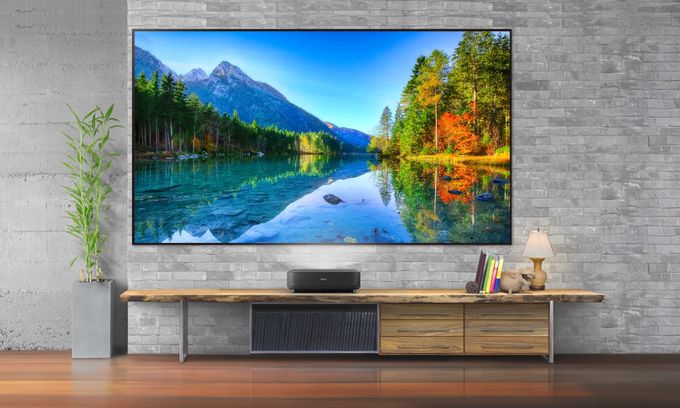This fall, Epson introduced the Lifestudio Grand EH-LS670 ultra-short-throw (UST) laser projector. Essentially, it became the flagship of the Lifestudio lineup, replacing the 2023 LS670 model.
The model is built on 3-chip 3LCD technology and provides brightness up to 3,600 ISO lumens. This technology uses three separate RGB LCD panels for red, green and blue colors.

In fact, each display controls the amount of light passing through. Then a prism re-combines the color images from panels in full-color image. This technology provides high brightness and color accuracy. In addition, the electronic way of creating the final image eliminates a rainbow effect (color break-up). It appears as a color border around the perimeter of contrasting objects.
Finally, unlike DLP projectors, it doesn’t use a color wheel as a color filter, which only passes one color at a time and filters out others. In turn, the lack of loss in light output ensures equal White Brightness and Color Brightness (Color Light Output), resulting in more saturated colors in the image.
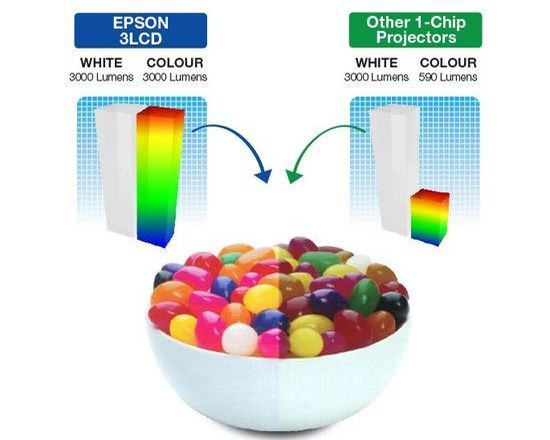
Key Features
The native contrast ratio of Lifestudio Grand is ~1,400:1 in Natural picture mode with Dynamic Contrast disabled, which is good for 3LCD technology. Additionally, the Dynamic Contrast setting at High Speed significantly enhances overall contrast. In fact, it’s Auto Irises, which optimizes light output depending on the average illumination level of the scene. It opens/closes the iris or changes the laser power. As a result, lumen output decreases in a dark scene, increasing black depth, and increases in a bright scene.
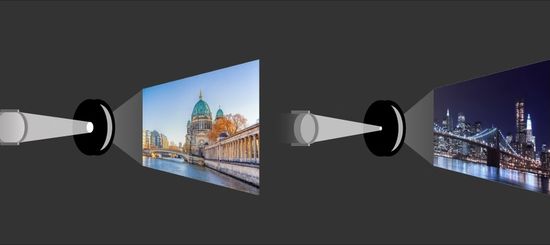
Grand EH-LS670 supports HLG and HDR10. Unfortunately, there is no support for HDR10+ and dynamic tone mapping. The latter function adjusts the image brightness for HDR content frame-by-frame in accordance with the display specs. Unlike static tone mapping with a single set of instructions for the entire video, dynamic tone mapping analyzes each frame. It preserves detail in both bright highlights and dark shadows, but sometimes reduces picture accuracy.

Therefore, for example, in HDR gaming companies offer to use HGIG (HDR Gaming Interest Group) settings without reducing accuracy.
Traditionally for UST projectors, the model has a fixed lens and does not offer optical zoom. However, a digital zoom with a ratio of 1:2.5 provides a throw distance of 0.3 m to 0.7 m from the screen, creating a projection of 60 to 120 inches diagonally (100″@10,5″).
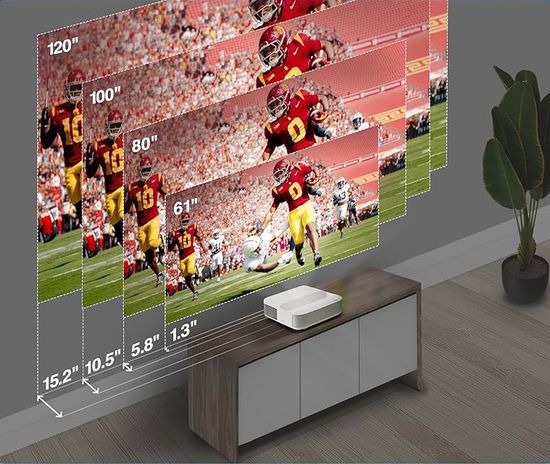
With dimensions and weight (5.7 x 18.4 x 6.2 inches)@16.6 lbs/7.7 kg, the Lifestudio Grand is one of the most compact UST projectors. Easy-to-use setup options include two front-leveling feet, manual focus, and keystone adjustments.
The Japanese giant positions the Lifestudio Grand as a Full HD model, but its patented pixel-shift-based 4K-Enhancement technology significantly increases image detail.
XPR vs 4K-Enhancement
DLP projectors use XPR (eXpanded Pixel Resolution) technology developed by Texas Instruments. Essentially, the 2.1 million micromirrors of the XPR-enabled 1080p chipset display 8 million pixels of the incoming 4K image at full 4K UHD resolution (3,840 x 2,160). To achieve this, an algorithm divides the 8 million pixels into four parts and sequentially displays four 1080p images, shifting them diagonally by half a pixel relative to each other. At any given time, the projector displays only one 1080p image. But due to the high frequency, our vision and brain perceive them as a single, higher-resolution image. The shift is achieved by tilting the lens using four electromagnets in the XPR module. Today, companies use 2-phase pixel shift (pixel doubling) in 0.66-inch (2.716 x 1.528) DMDs or 4-phase pixel shift in 0.47-inch (1.920 x 1.080) microchips.
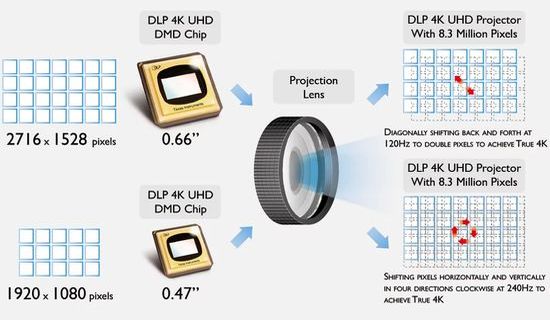
Despite the chipset’s native 1080p resolution, manufacturers of XPR-enabled DLP projectors initially market them as 4K models. Sometimes, some experts ‘debunk’ them, although the manufacturers make no secret of it.
Epson is more meticulous about this aspect and, to avoid criticism, lists the native resolution of such projectors as 1080p. However, the company also uses pixel shift-based 4K-Enhancement technology. Essentially, it duplicates a single 1080p image, shifting it by half a pixel. The algorithm then combines the two images, creating the illusion of a higher-resolution image.

In fact, this feature is similar to upscaling in TVs and is designed for use with Full HD content. XRP is designed to reproduce native 4K content. Epson’s two-way pixel-shift technology provides better color accuracy and higher brightness, while XRP offers the highest possible sharpness and the fastest response times.
Color Modes
The list of color modes is typical and includes Dynamic, Standard, Cinema, and Natural. Their names are identical for SDR and HDR modes, but the projector retains individual settings. When you select color mode, the system automatically uses the settings appropriate to the type of incoming HDR or SDR signal.
Of course, the list of settings includes the traditional Brightness, Contrast, Saturation, Tint and Sharpness. More advanced calibrationand is achieved with a Gain and Offset controls. Finally, the model is equipped with a full-featured color management system (CMS) for fine-tuning the hue, saturation, and brightness of both primary and secondary colors.
The list of additional picture controls will please meticulous perfectionists. It includes Dynamic Contrast (Normal and High-Speed options), Scene Adaptive Gamma (Off, Low, Medium, or Strong), and Projection Preference (Fine or Bright). In fact, they are designed to optimize brightness or contrast according to the viewer’s personal preferences.
Dark, Normal, and Bright in Gamma settings correspond to 2.3, 2.1, and 1.9 respectively.
However, the image quality ‘out of the box’ is quite high and does not require using most of the settings. With the exception of a slight shift towards warm, Natural picture mode provides the most accurate colors for both SDR and HDR. However, the less accurate Standard picture mode offers a cooler image with increased blue tones.
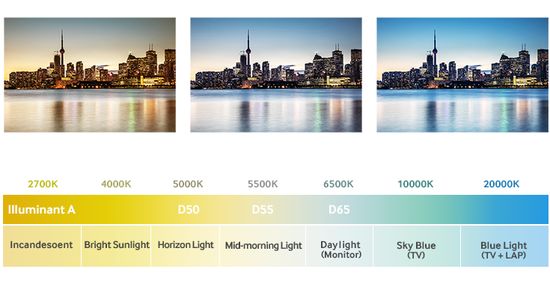
Unfortunately, the color gamut of Laser Phosphor light engine is only ~80% for DCI-P3 and ~60% for BT.2020, which slightly limits color accuracy.
For reference, Dynamic Contrast in the High-Speed mode provides the best results for most video content.
Measured brightness (SDR/HDR Mode, ANSI lumens):
– Dynamic ~ 3,770;
– Standard ~ 3,550;
– Cinema ~ 3,440;
– Natural ~ 3,320.
Smart platform, gaming and audio
The Lifestudio Grand uses Google TV smart platform, which is one of its bonuses. Accordingly, the lucky owner receives quick access to popular streaming services, including Netflix, HBO Max, Disney+, Prime Video, etc and access to the Google Play Store for downloading additional apps.
The new projector can hardly be positioned as a gaming projector. Input lag of 34ms for 4K@60Hz and 24ms for 1080p@60Hz/120Hz in ALLM (Auto Low Latency Mode) or Game Mode is suitable for casual gaming, but a bit steep for competitive matches. By comparison, input lag in modern gaming models starts at 4ms.
The 20W 2.1-channel audio system by Bose and the Epson Projection Studio app round out the projector’s list of bonuses. Despite its compact size, two 45mm full-range drivers and an 80mm ported enclosure provide surprisingly impactful audio.
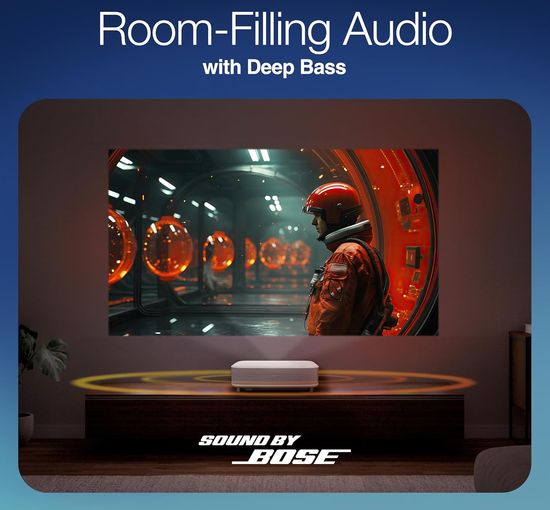
For most, this makes an external soundbar unnecessary. However, for music lovers, the developers have included an HDMI 2 port with eARC (Enhanced Audio Return Channel) for high-quality audio transmission to an external audio system in digital format and without loss.
Epson’s Projection Studio app provides seamless connection to the any Lifestudio projector for instantly share slideshows, movies, and other media directly to the projector.
Conclusion
Pros
– relatively affordable price (~ $ 2,200 / £ 2,200 / € 3,000);
– 3,600 ISO lumens white and color brightness (Color Light Output);
– Google TV operating system with access to Netflix amd 10,000+ apps;
– good built in sound system;
– high color accuracy;
– Projection Studio app to connect for iOS and Android devices;
– dynamic contrast ratio up to 5,000,000:1.
Cons
– no 3D support;
– limited color gamut;
– no HDR10+ support;
– no dynamic tone mapping.
Of course, price is one of the model’s main bonuses. For comparison, prices and brightness of the best new UST projectors:
– Hisense L9Q ~ $ 6,000, 5,000 ANSI lumens;
– Samsung The Premiere 9 LPU9D ~ $ 5,765, 3,200 ANSI lumens;
– Epson QS100B ~ $ 5,000, 4,500 ISO lumens;
–JMGO O2S Ultra~ $ 3,000 (MSRP), 3,600 ISO lumens;
–Hisense PT1 ~ $ 2,500, 2,500 ANSI lumens.
According to the specs, the Lifestudio Grand is inferior to its competitors in resolution (Full HD vs 4K). However, this is mainly due to the meticulousness of the Japanese giant, which prefers to avoid accusations of inaccurate specs. Firstly, the compared projectors utilize pixel shifting differently. DLP models use pixel shif-based XPR (eXpanded Pixel Resolution) technology to play 4K content using a 1080p chipset. Epson also utilizes a 1080p chipset. But it increases the resolution of Full HD content with 4K Enhancement by duplicating and shifting the image. However, in most cases they provide approximately the same image detail.
This video introduces the new Epson Lifestudio Grand projector.
